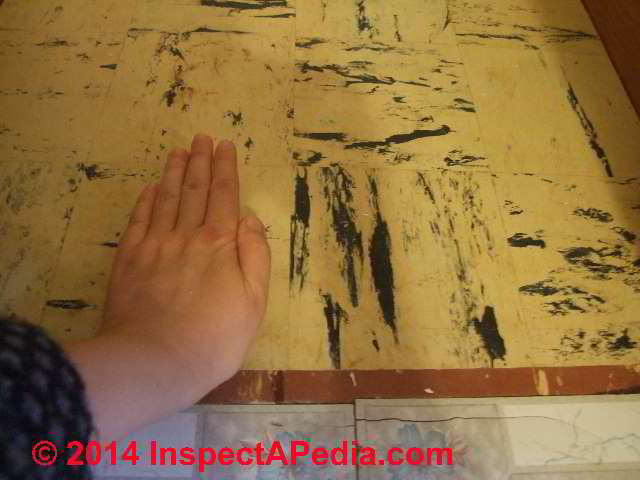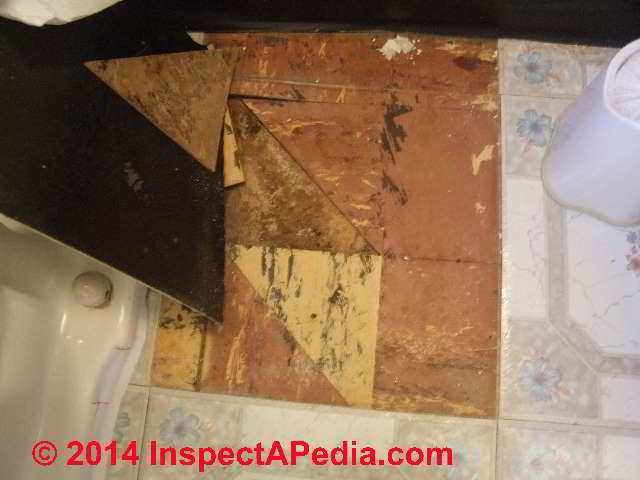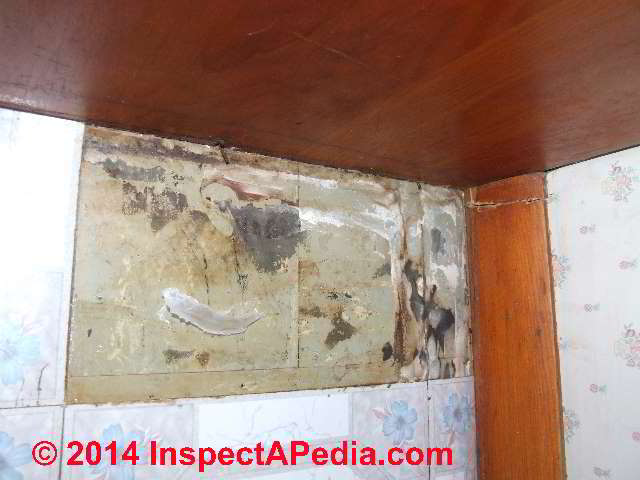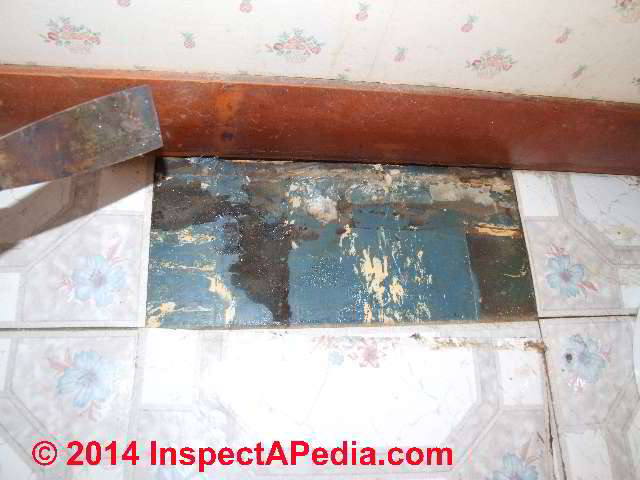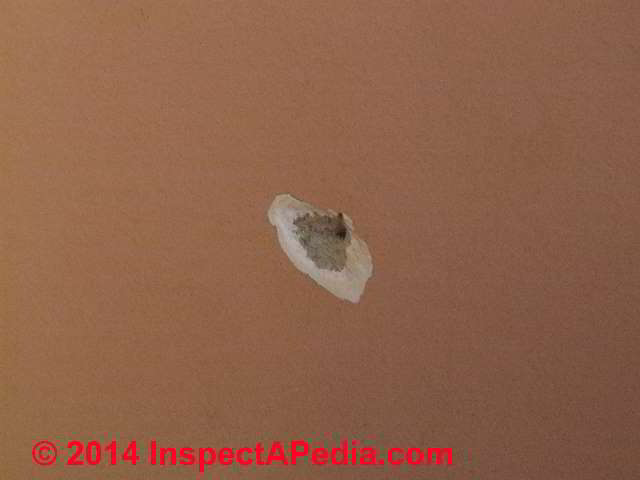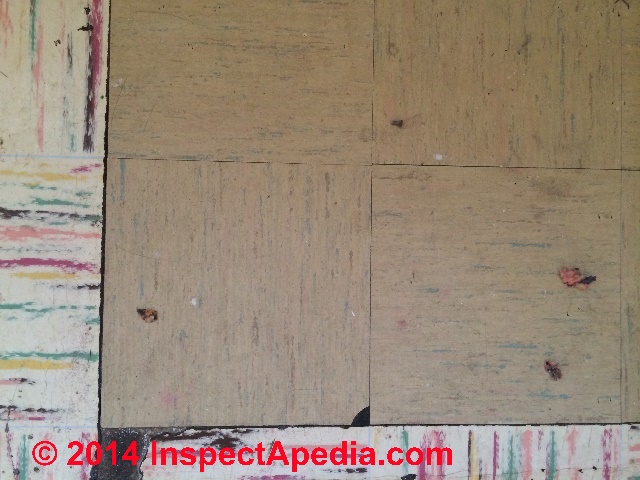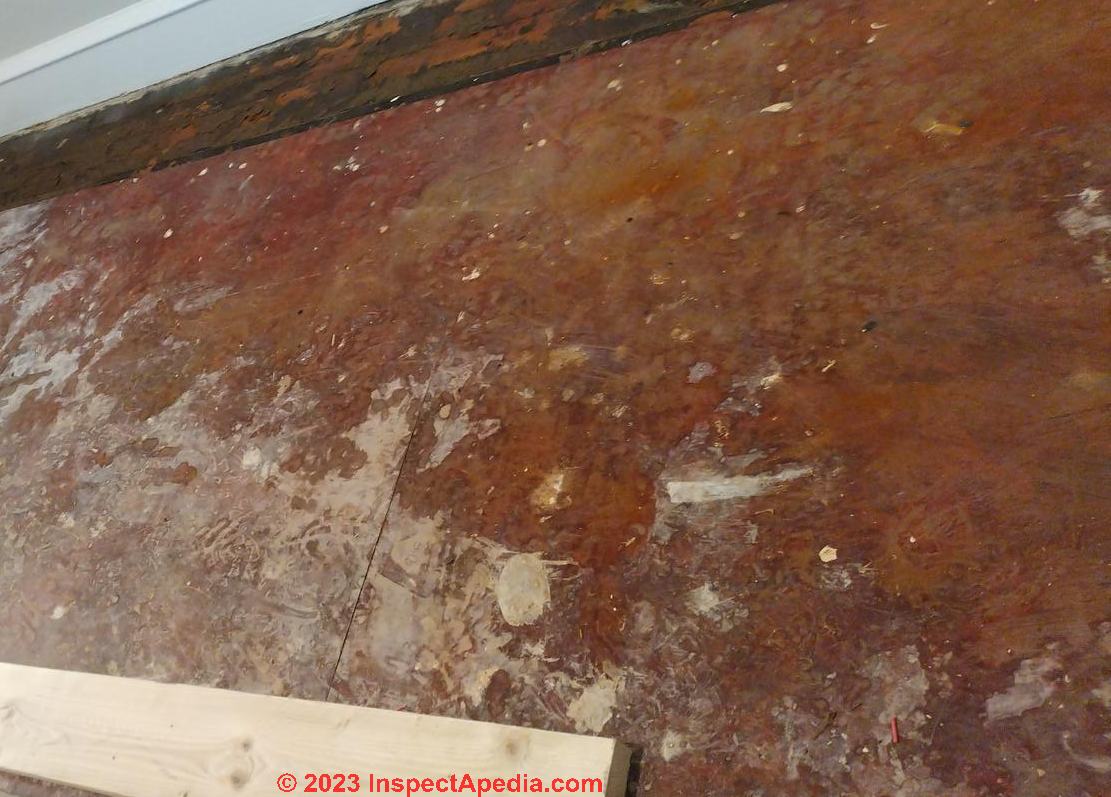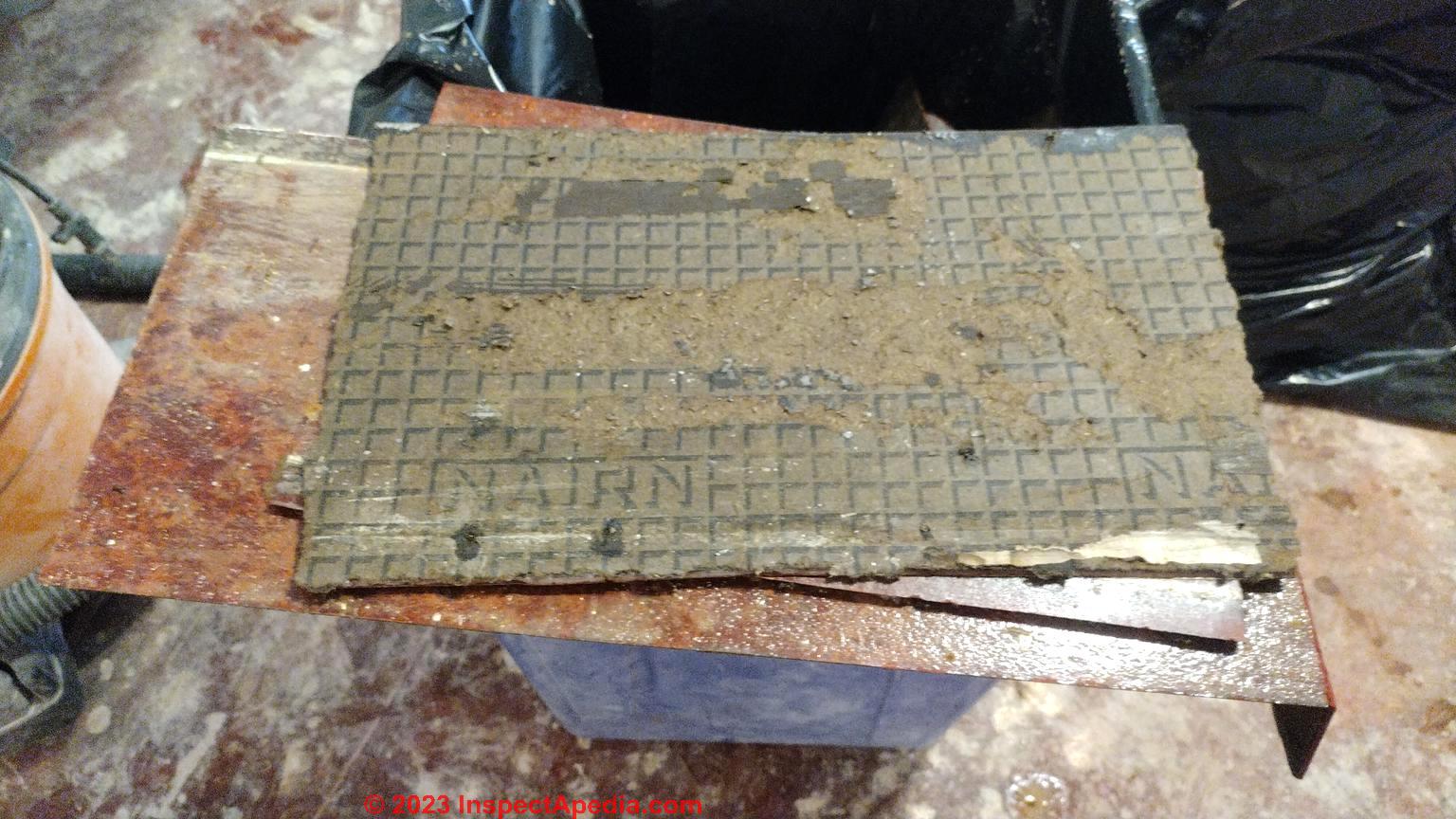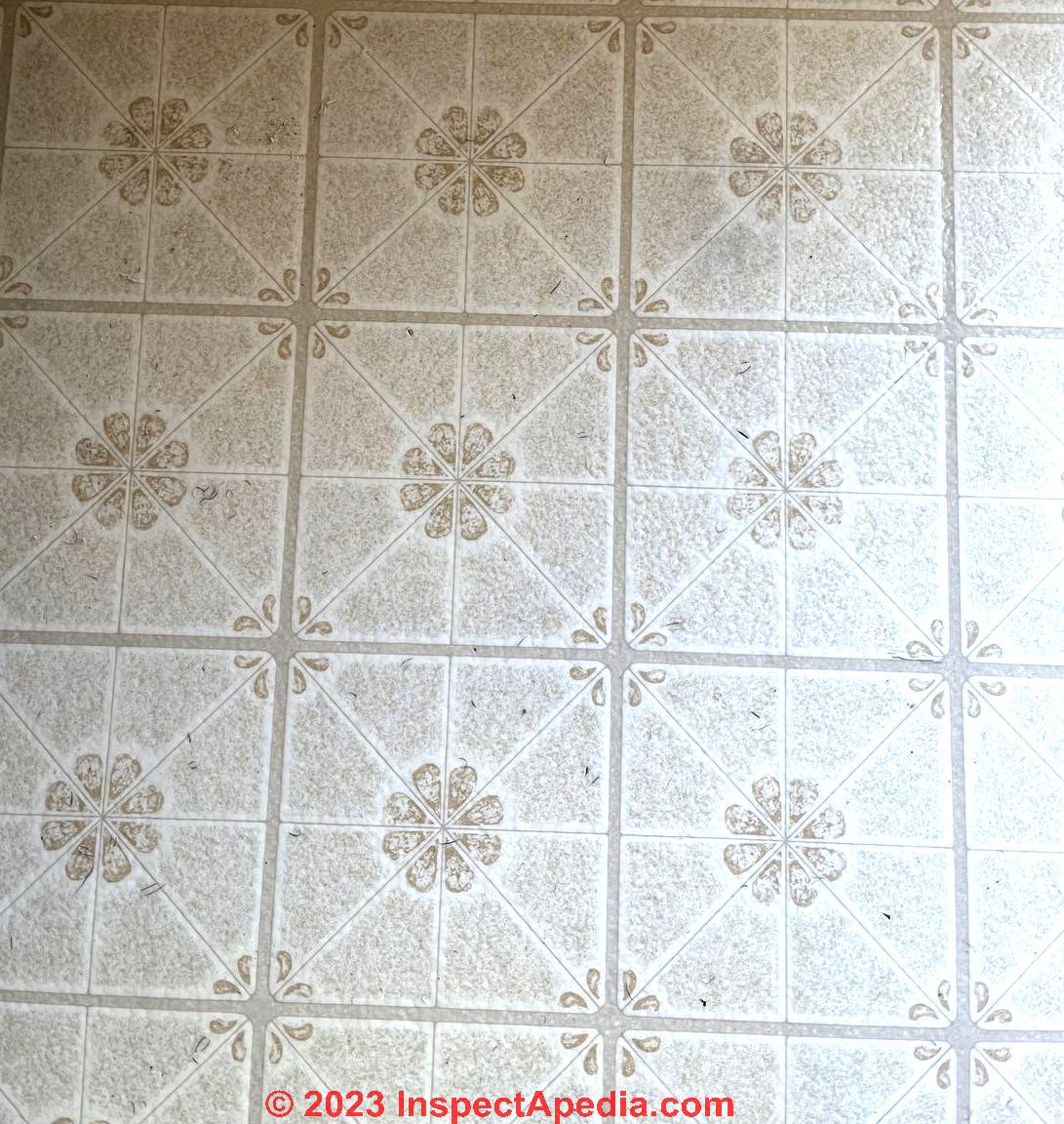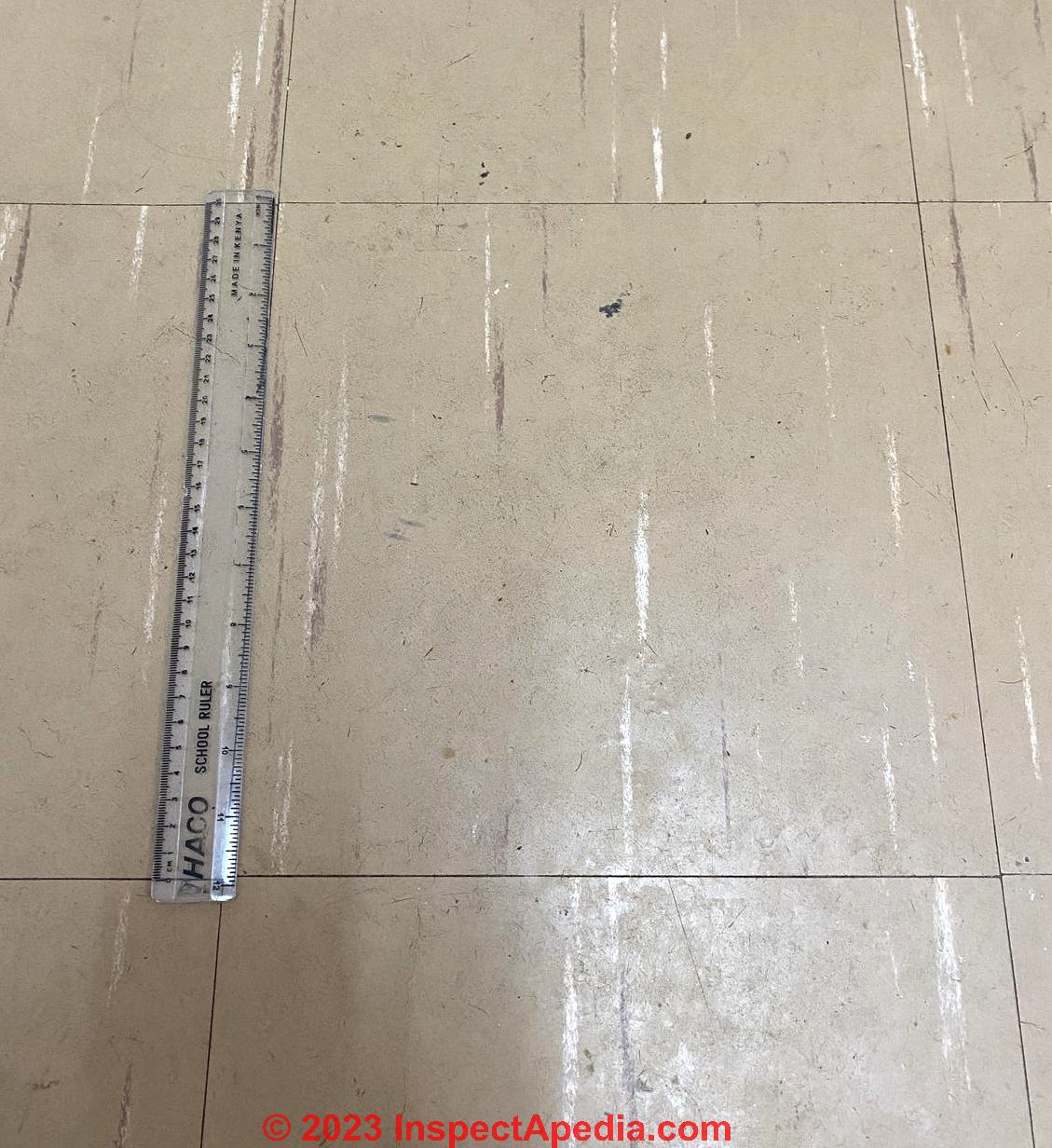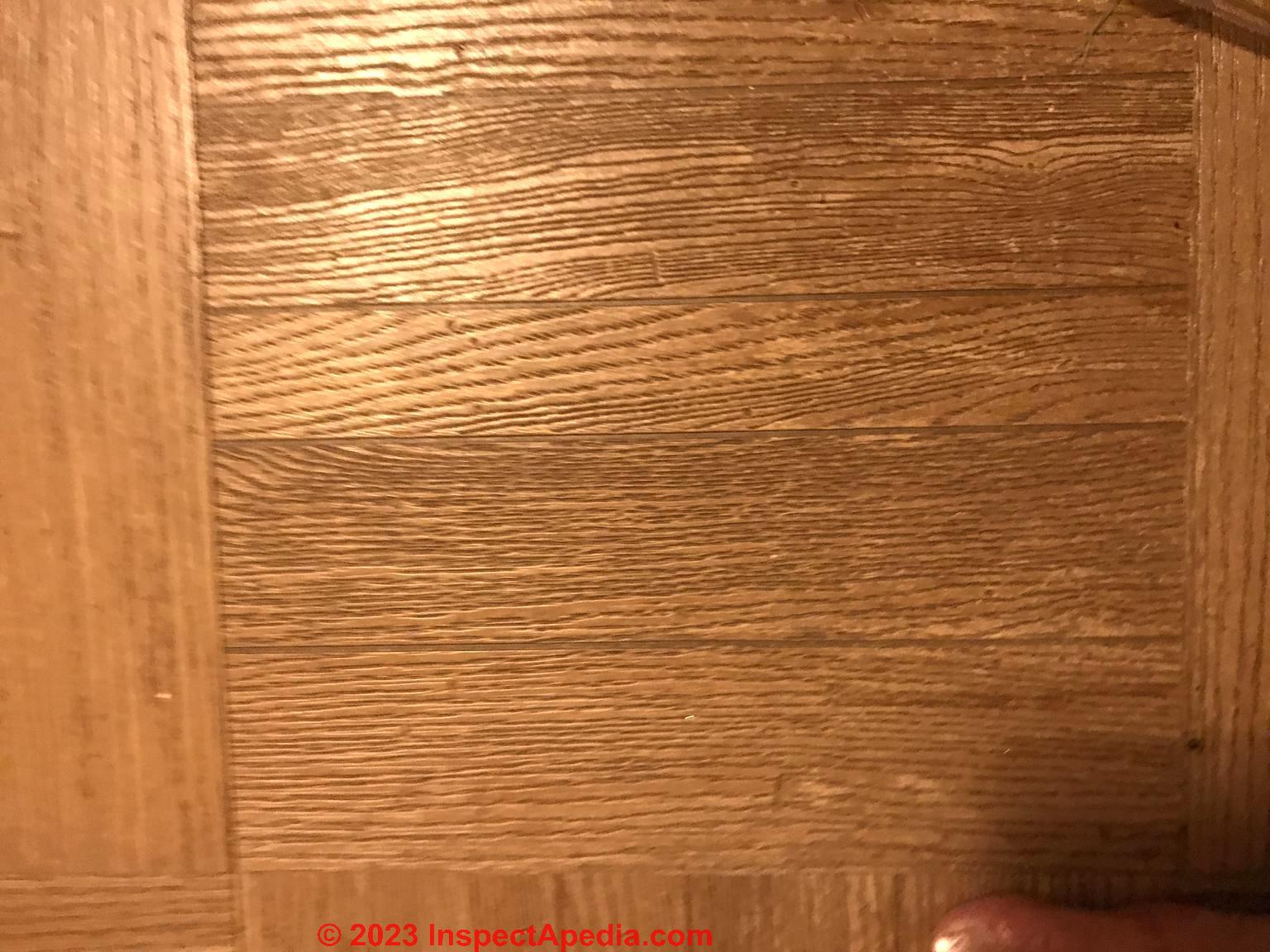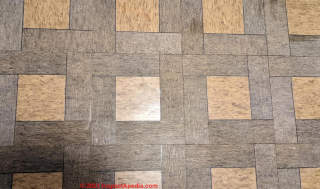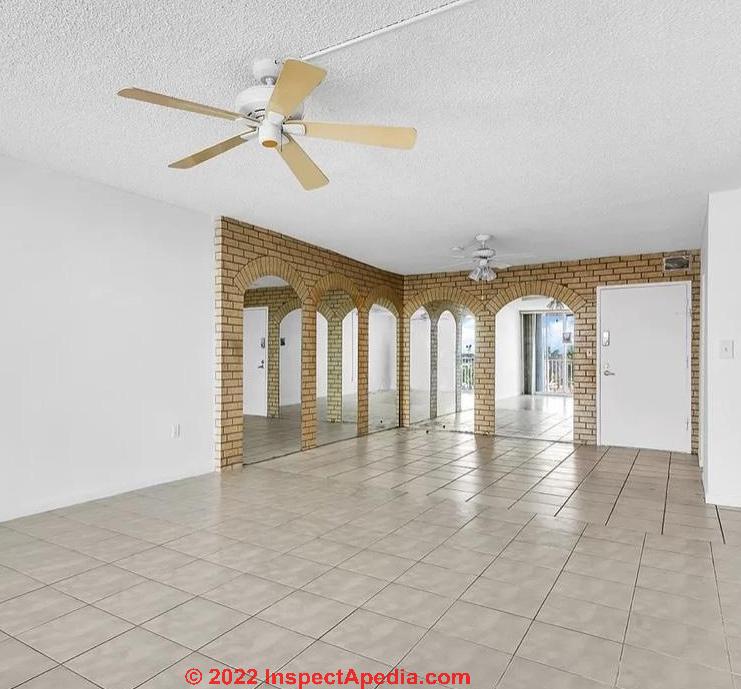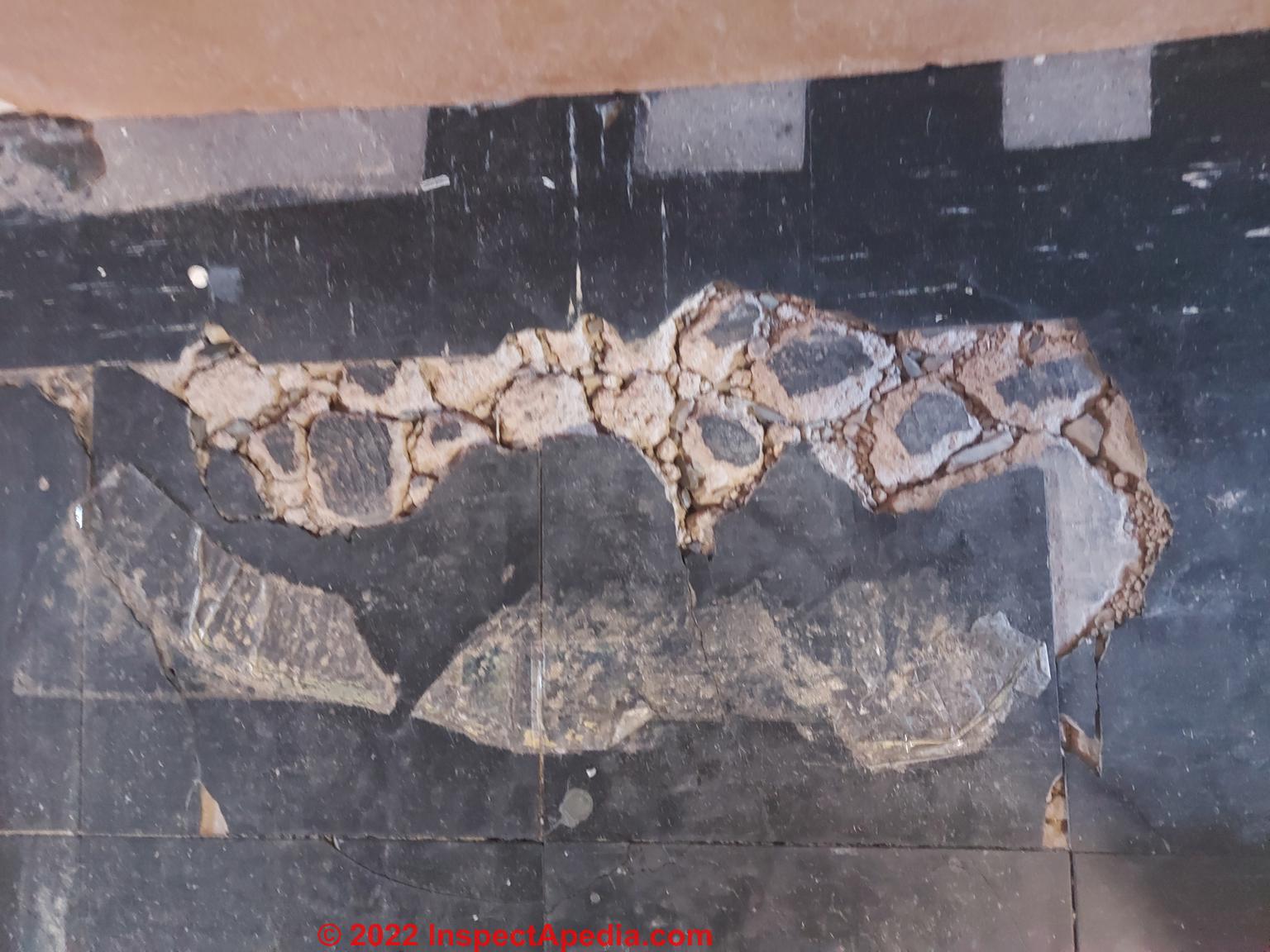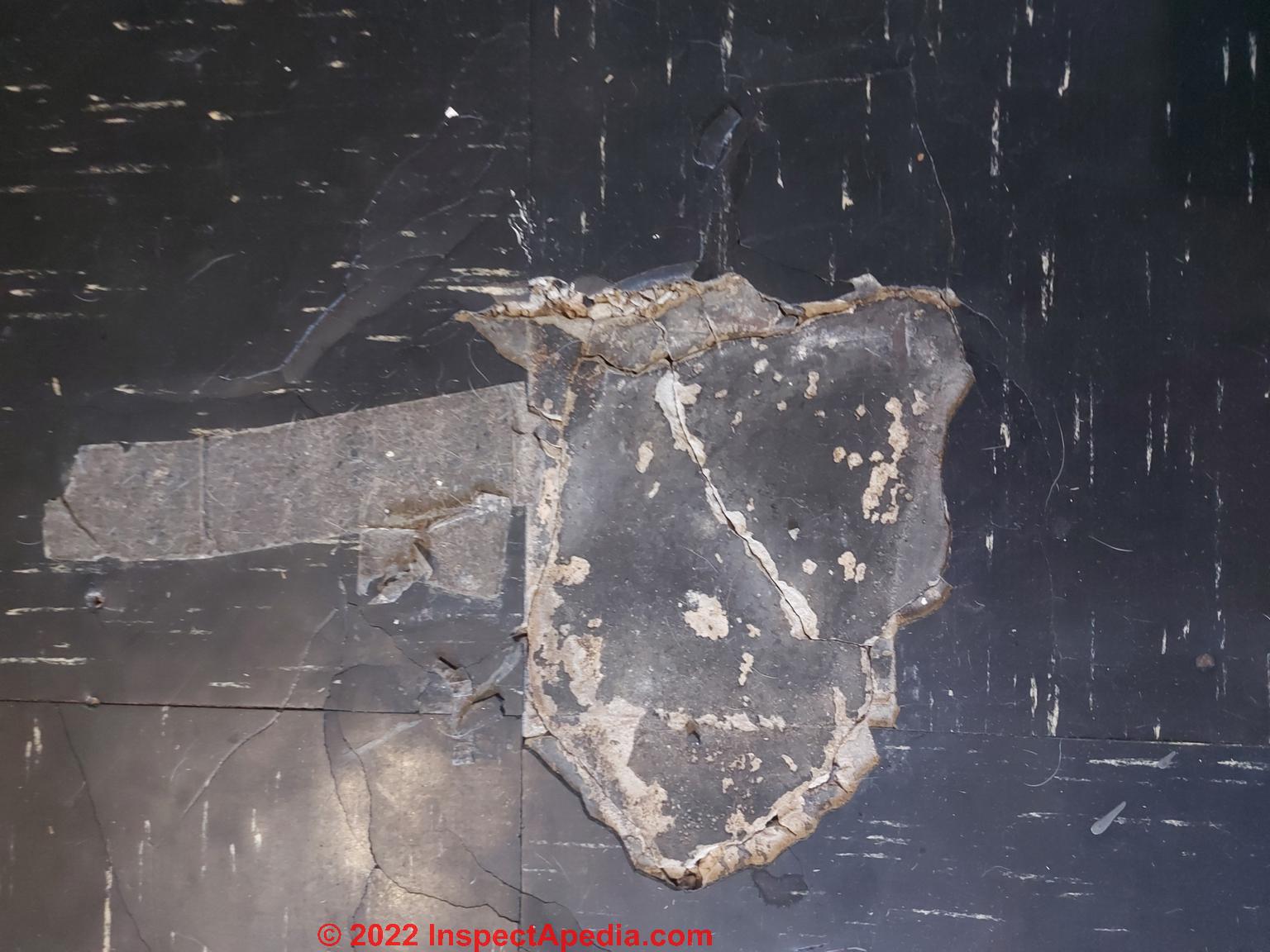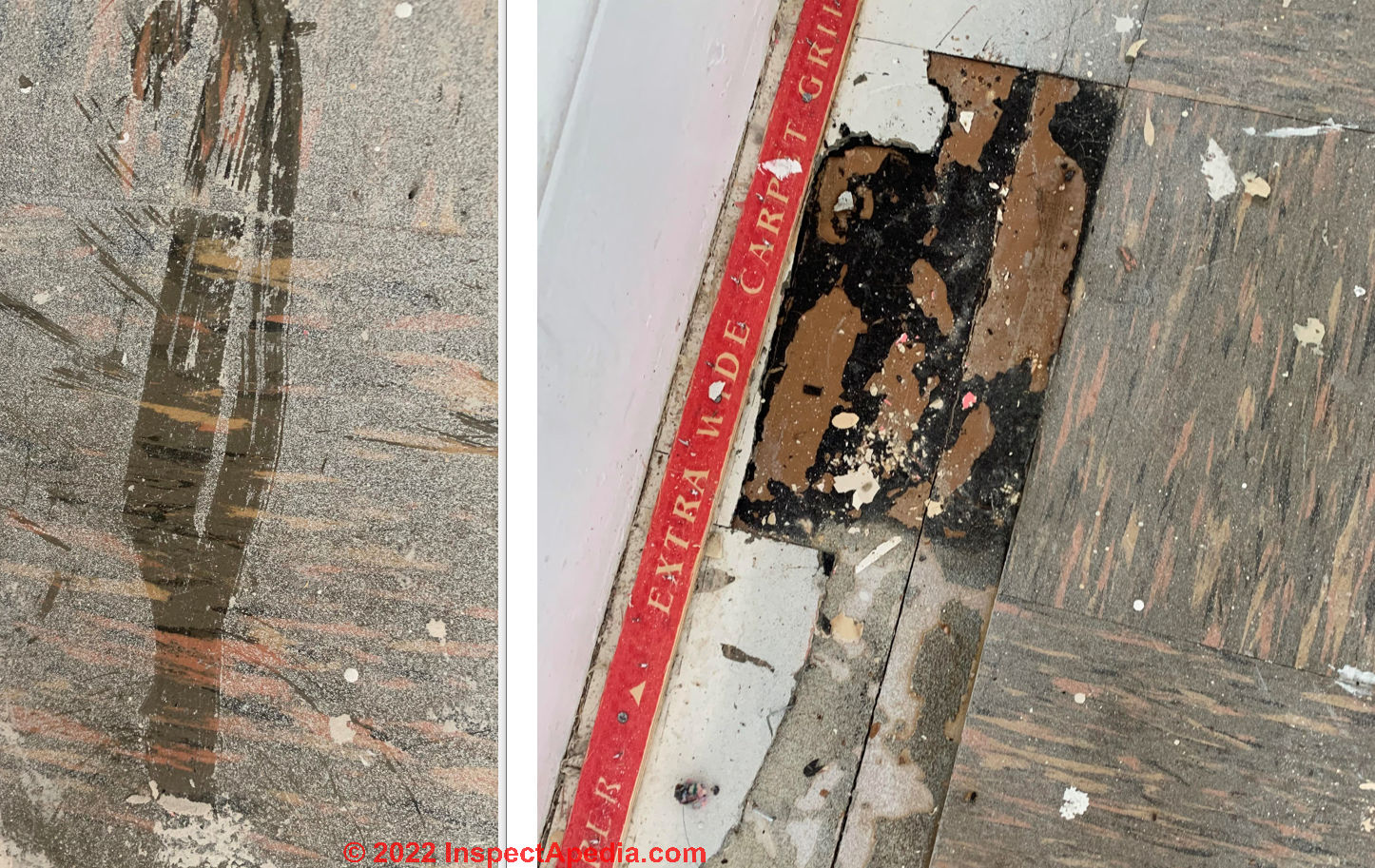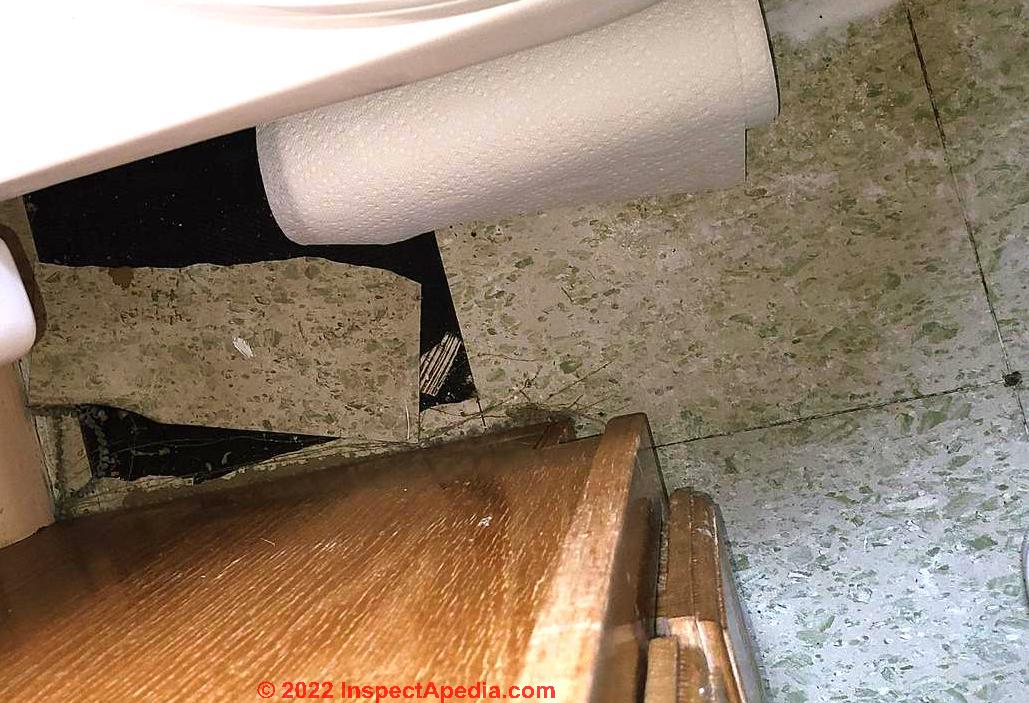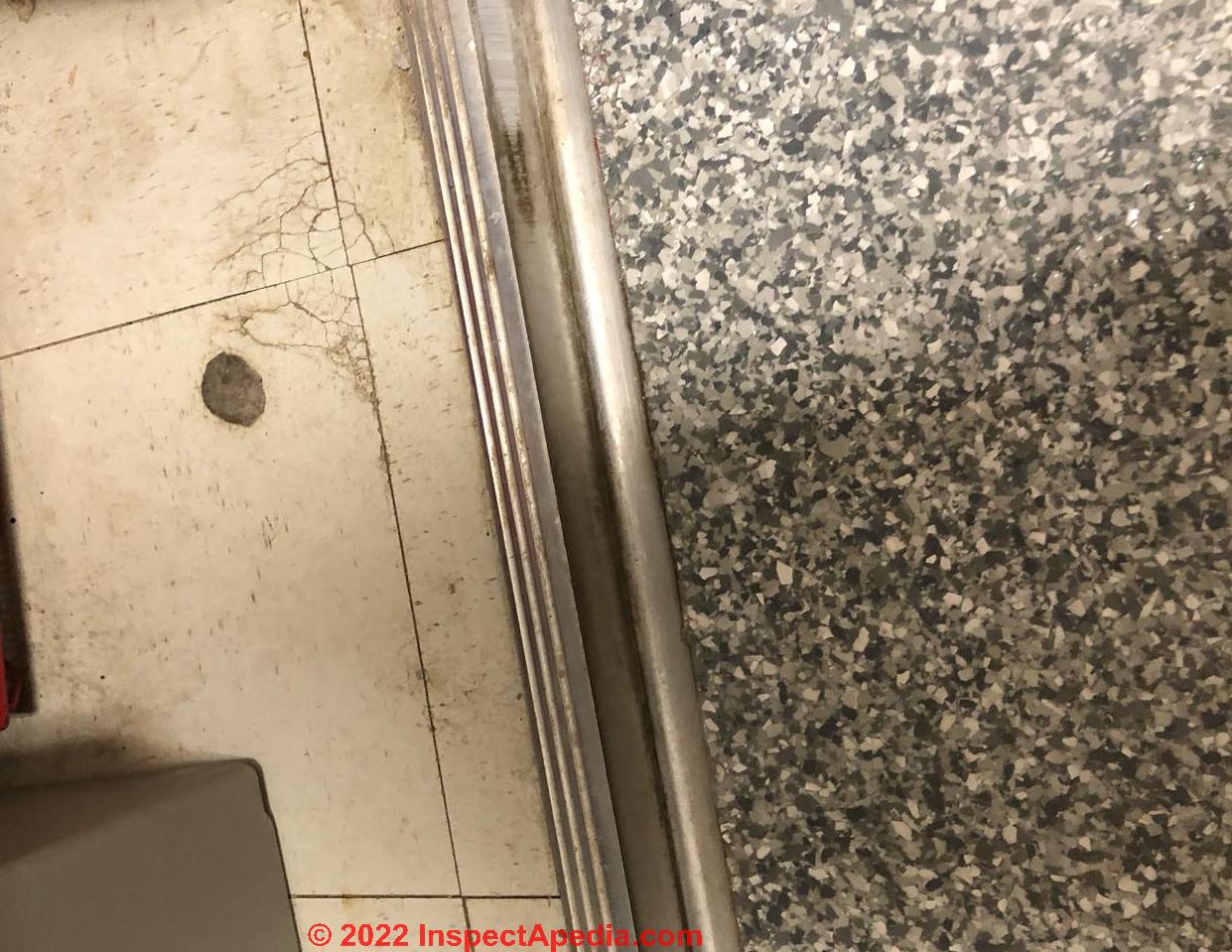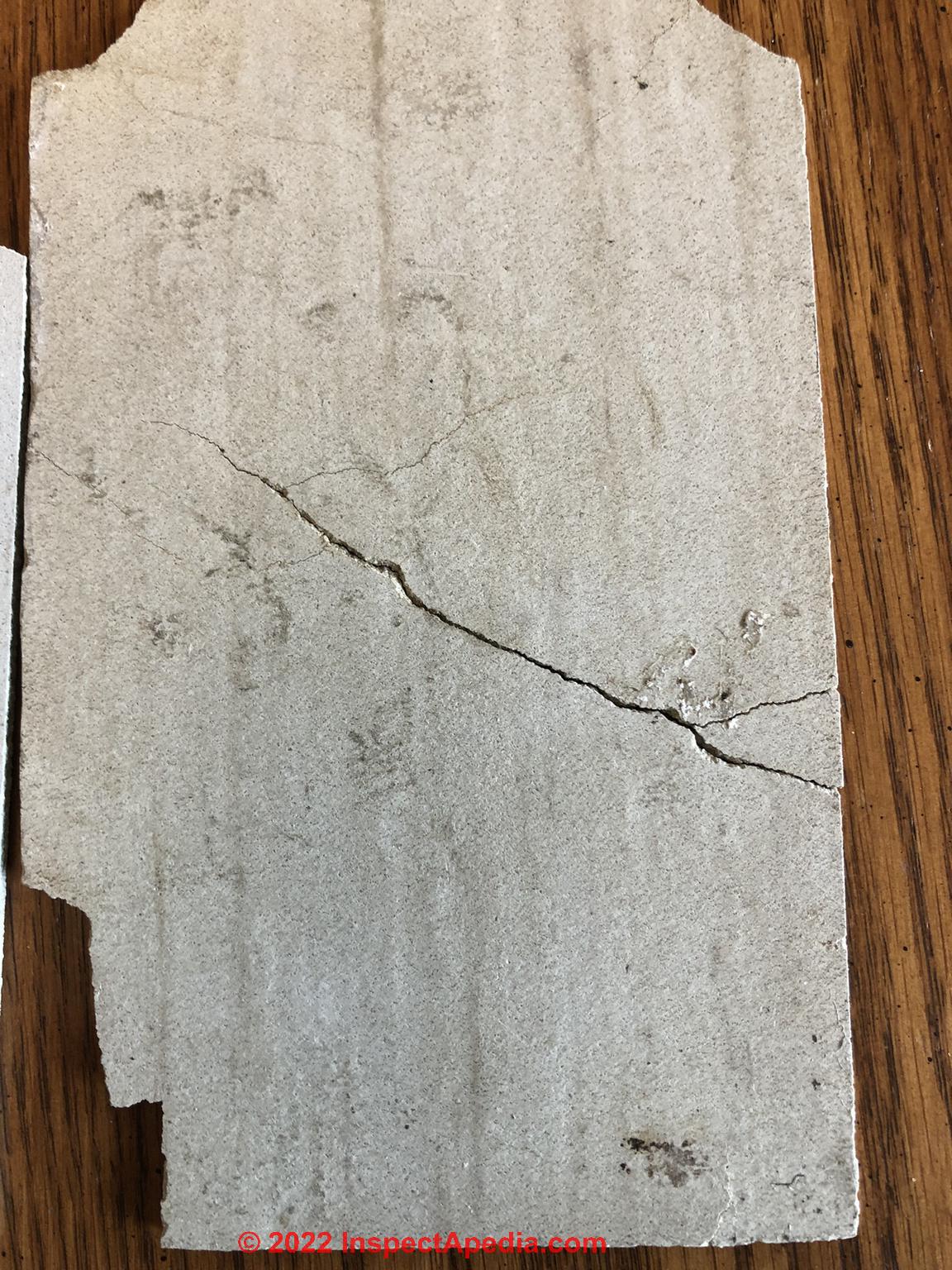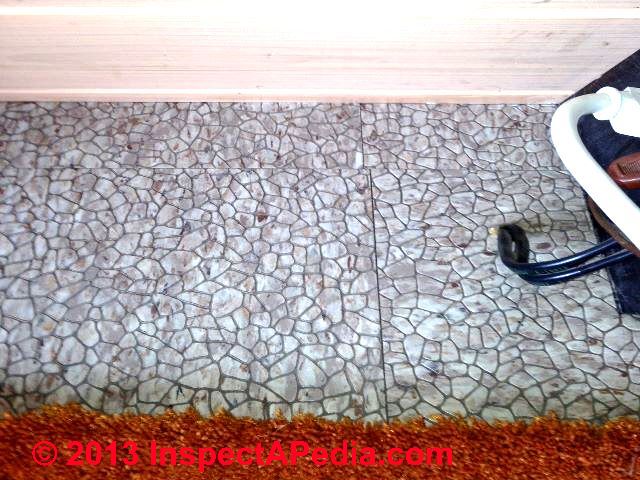 Asbestos Floor Tile Identification QA
Asbestos Floor Tile Identification QA
Submit Photos to Identify Asbestos Floor Tiles
- POST a QUESTION or COMMENT about how to identify asbestos-containing flooring materials and what to do when asbestos-containing floor tiles or sheet flooring are found in a building.
How to submit photos of flooring to get help in identifying floor tiles or sheet flooring that might contain asbestos.
This article provides photos from our readers who asked for help in identifying floor tile or sheet flooring age and possible asbestos content. The article begins with photos of 1950's era asphalt asbestos floor tiles.
This article series includes a photo-gallery of pictures of floor coverings submitted for identification along with comments on findings, recommendations, & asbestos content. Readers can use our page bottom COMMENT BOX to submit photos of flooring to get help in identifying floor tiles or sheet flooring that might contain asbestos.
InspectAPedia tolerates no conflicts of interest. We have no relationship with advertisers, products, or services discussed at this website.
- Daniel Friedman, Publisher/Editor/Author - See WHO ARE WE?
Photo Gallery of Requests to Identify Possible-Asbestos Floor Tiles
 We provide photographs and descriptive text of asbestos insulation and other asbestos-containing products
to permit identification of definite, probable, or possible asbestos materials in buildings.
We provide photographs and descriptive text of asbestos insulation and other asbestos-containing products
to permit identification of definite, probable, or possible asbestos materials in buildings.
Our photo shows Armstrong® Excelon 12x12 vinyl asbestos flooring made in 1972, identified in our detailed photo guide to asphalt asbestos and vinyl asbestos floor tiles, and resilient flooring produced in 1900 -1980. (links below)
In the article below we arrange the flooring photographs and discussion about identification of the floor and about possible asbestos content and asbestos risk management roughly in order of the reported age of the building or flooring installation.
The best and quickest way to make an educated guess (without a lab test) about whether or not your floor tiles or sheet flooring contains asbestos is to
see DOES THIS FLOOR CONTAIN ASBESTOS?
5 questions we pose there and whose answers can help you make a reasonable guess at whether or not a particular floor tile or sheet flooring contains asbestos.
- Please, before sending us email asking to identify floor tiles, sheet flooring, linoleum, etc.
try using our ASBESTOS FLOORING IDENTIFICATION procedure or our photo catalog of floor tiles
and sheet flooring that may contain asbestos beginning
at ASBESTOS FLOOR TILE IDENTIFICATION PHOTOS 1949-1959 - For identification guides to all brands of asphalt asbestos, vinyl asbestos, and similar flooring products
see ASBESTOS FLOORING IDENTIFICATION GUIDE INDEX - all brands, all years - To identify unknown flooring products:
at ASBESTOS FLOOR TILE PHOTO ID REQUESTS we include additional photographs of both tile and sheet flooring products submitted by readers with requests for more information. - To identify resilient or sheet flooring or sheet-forms of resilient flooring that may contain asbestos are now found
at RESILIENT SHEET FLOORING ID GUIDE
If you have tried looking through our example flooring photos by year or flooring manufacturer and were unable to identify your flooring then feel free
to CONTACT US to send along photos and a description (age, dimensions, building history) of flooring that you are unable to identify
Asbestos is safe and legal to remain in homes or public buildings as long as the asbestos materials are in good condition and the asbestos can not be released into the air.
1950's Floor Tile or Sheet Flooring Identification Requests
This article contains flooring identification requests for floor tiles or sheet flooring believed to date from the 1950's.
For a 1950's vintage asbestos-containing floor tile photo guide, please also
see 1951-1959 ARMSTRONG ASPHALT ASBESTOS FLOOR TILE PATTERN & COLOR GUIDE, 9"x9"x1/8"
or see our complete list of flooring identification photo guides
at FLOOR TILE / SHEET FLOORING PHOTO GUIDES
Question: asbestos content of 6" x 6" floor tiles in a 1953 home
Could 6x6" tiles contain asbestos? I can't find any information on tiles listed at this size. I have 4 different colored tiles (The bathroom/kitchen/hall have a main color and an edge color).
They don't look exactly like any of the tiles or colors, but the pattern is similar to 1955 - Armstrong Excelon Vinyl Plastic Asbestos Floor Tiles, Patterns & Color Guide Navajo Gray 781.
The kitchen/bath/hall also have lightly popcorned ceilings with a slight sparkle. Part of the bathroom ceiling was removed for mold remediation and there is definite dust left over.
The house was built in Massachusetts in 1953. All other flooring (2 little bedrooms and a small living room) is hard wood with drywall for the walls and ceilings (with a little Spackle-ish stuff).
I'm going to guess I will just have to find somewhere and send out a piece of each tile and some ceiling. I feel awful as I have a little guy and I'm worried about hurting him.
Could my 6"x6" tiles and popcornish sparkly ceiling contain asbestos? Can the air be cleaned or tested from the ceiling removal?
A relative that is helping me clean the house swears that since the tiles are in good shape, we can just peel them up with a trowel or maybe iron the area to soften the adhesive. There are newer sticky tiles on top of the potential asbestos ones and these are lifting up and coming off.
I've been researching your site but I am getting very nervous because of my little guy.
I thought I'd ask first as I am in a bit of a tight financial budget with all the first time home buying fees but thought I was lucky to get a pretty good deal on a home. I really appreciate your time and information, ~L. 1/11/2014
Reply:
Certainly if the flooring you describe dates from the 1950's or as late as the late 1970's it should be handled with the presumption that it contains asbestos.
This is not a reason to be frightened, as unless someone has already made a dusty mess by grinding, sawing, or similar dust-producing demolition, the hazard of airborne asbestos is probably low, possibly below the limits of detection.
Take a look at the asbestos flooring removal and flooring hazard reduction risk management articles given just below for some suggestions.
If you can send me some photographs [provided by the reader and shown just above] of your flooring I will research further.
Our standard advice is that in cases where you face a possibly costly demolition or cleanup project it makes sense to have the material tested by a certified asbestos test lab (link given below). But simple encapsulation approaches for a building that has not been contaminated with demolition dust are often sufficient.
Similarly, depending on when it was applied, textured ceiling paints and popcorn ceiling paints often contained asbestos and also deserve special handling. Often rather than face a costly demolition and cleanup a contractor will simply laminate a new layer of 1/4" drywall over the old ceiling to provide a safe encapsulation of the original coating. Actual removal of an asbestos-containing textured ceiling is a more messy project that we'd like to avoid.
See also CEILING PAINT TEXTURED / POPCORN ASBESTOS
Reader follow-up:
I can also provide pictures. Some of the house's wall paper was also already removed. I'm looking to see if this is also something to test.
Here are some photos from the house. [Shown above] I have labeled the photos by room. I will be getting a "D-Lead Paint Test Kit" today and really hope the paint is okay.
There is one photo of the bath ceiling where you can see the half furthest away, which is the section that was cut and replaced during mold remediation. The mold remediation was carried out by the seller before we bought the house.
Reply:
I agree that those floor tile patterns match older asphalt-asbestos flooring patterns we've collected from catalogs, readers, and some readers who've tested the tiles.
The bath floor tiles and kitchen floor tiles that you indicate are 6-inch in size (did you actually measure these?) are of patterns matching the Aztec asphalt-asbestos flooring we've documented.
I'd certainly like to see a photo of these tiles with a ruler in the image.
While 9x9 inch asbestos-containing floor tiles (and 12-inch tiles) are common in older homes, yours are the first field-photos I've seen of these in the small 6-inch size in this pattern.
See ASBESTOS FLOOR TILE PHOTO ID GUIDE - home: 1950-1986+ where we include photos of the Armstrong Seneca floor tile pattern that our records asserted were sold only in 9x9" sizes at that time.
(Kentile and some other manufacturers indeed produced asbestos-containing floor tiles in quite a variety of sizes and shapes including strips, stars, and other patterns, so six-inch floor tiles are not unimaginable).
We don't know the age of these floors but I'm guessing from the size and pattern that they date from the 1950's.
Asbestos was used in both asphalt asbestos flooring and vinyl-asbestos flooring up to the early 1980's (which means new old stock could have been installed within a few years after the manufacturers had stopped producing asphalt-containing flooring).
Historical note: Which companies made asbestos-containing flooring in 1981?
Some incompletely-documented sources (including TSCA 1982 and ICF 1984) list six producers of asbestos-containing flooring in 1981:
- American Biltrite (Amitco division),
- Armstrong World Industries,
- Azrock industries,
- Congoleum Corp.,
- Kentile Floors, and
- Tarkett Corporation.
But the patterns in the flooring photos you've provided look like Armstrong products.
Asbestos in Plaster, Lead Paint, Wallpaper Arsenic Warnings
Moving off of the topic of asbestos-containing flooring I'll comment on two other photographs you included of plaster wall damage and peeling paint and peeling wallpaper.
OPINION: Your bedroom wall photo (at left) shows minor damage probably where a nail was removed, in a plaster wall. I've seen claims that some plaster may have contained asbestos but as the material is quite hard (not friable) I think the concern for walls in good condition would be the paint not the plaster - as long as you're not doing dusty demolition.
Your kitchen wall photo (below left) shows peeling wallpaper and peeling paint. (Some very old wallpapers included arsenic in the dyes used to make green patterns).
See details at WALLPAPER ARSENIC + MOLD POISONING
Also see ARSENIC HAZARDS at BUILDINGS
Typically I remove wallpaper by wetting or steaming it to try to remove it in large pieces.
Typically I remove loose paint HEPA vacuuming and taking appropriate dust and lead paint control measures, and where plaster is sound and we're just considering painting, I seal the wall with a lacquer primer sealer before applying the finish coats.
Lead paint, depending on your state and local jurisdiction rules, may require additional steps including removal at some floor heights and other locations.
(A pet worry of mine is lead-painted window sashes that make dust picked up on window sills by the sticky fingers of toddlers.)
From the age of the home I'd be careful about renovating ANY painted surfaces without first determining the lead paint hazard and appropriate remedies.
OPINION: The textured ceiling photos [below, click to enlarge] look like a paint-on product but covered with additional layers of paint.
Some of those definitely contained asbestos.
See DOES THIS MATERIAL CONTAIN ASBESTOS? - 5 easy questions to tell if a BUILDING MATERIAL probably contains asbestos -
Your choices are to treat the material as asbestos-containing or to collect a small sample for testing.
Your test lab can give detailed instructions. Usually it's a simple process involving wetting a small area to remove a sample that is bagged and sent to the lab.
Reader follow-up: testing for asbestos in flooring, in air, in mastic, in dust
I am wondering if I should cancel the lab that I have scheduled for Thursday (tomorrow). The lab said they would do 6 sample tests for $200, this would be 4 tiles (they insist that different colored tiles be tested), 1 ceiling, 1 mastic, and an air and dust test for free.
The company is "Environmental Sampling & Testing LLC" 54 Water Street Ashburnham MA 01430. With a CLD Class D Certificate. There is usually additional cost but they gave us a break due to our situation.
They do the tests but not remediation. They do refer for remediation if the tests are positive.
I used a "Klean Strip D Lead Test Kit" which is supposedly EPA Recognized & ETV Tested to detect Lead & Lead Chromate in all layers of paint. The kit uses sodium sulphite, it seemed less likely to give a false positive like the swabs. All of the paint under the wallpaper and on the plaster came back negative. Hurray!
Your idea of making a new surface with drywall is amazingly, logically smart. With these test results it looks like I may be able to just scrape the paint. I was looking at Inspectapedia and I did not see a specific primer mentioned. Would the Zinnser Water based shellac or an oil based primer work?
I am looking through Massachusetts law to see if there is anything missing regarding tackling the tiles. Perhaps I will get the lab tests and then proceed with covering them. It may be good to know for sure concerning the ceiling and tile glue.
I will get some more photos of the tiles. The box I have is for the newer tiles but I will get all many kinds of pictures and measurements. Would it be bad to pull up some tiles to get a better look? My primary concern is my 10 month old.
I like your reference to the tiles not being radioactive. Very True! For some reason having someone small who relies on me for everything makes it hard to wrap my mind around perceived dangers even with the right knowledge.
Reply: "OPM" other people's money - concern: getting advice that is safe for you but mostly safe for the consultant you asked - at your expense
Below opinions include the "OPM" other people's money - concern: if you ASK someone they will almost always suggest that you spend your money on testing and inspections - not necessarily because it's clearly justified but because it's the safe thing to do - safe for them - as it avoids you later being angry that they didn't give you advice to be more aggressive or more cautious.
Regarding your questions:
Do you think it would be advisable to:
-Have and air test for asbestos/lead/arsenic
-Have a dust test for asbestos/lead/arsenic
-To look for some EPA type group to come in and provide advice -
Air tests for asbestos are most likely going to be junk science for the situation you describe.
The level of asbestos in a residential home's air due to vinyl asbestos flooring that has not been disturbed by grinding, sanding, sawing, or aggressive demolition is likely to be below the limits of detection, and furthermore, testing the indoor environment after a professional cleanup, if one is required, will be most likely SOP for the firm providing that work.
Settled dust tests are usually cheap and can be done to reduce your level of worry but are unreliable unless collected with real thought. Dust tests before a professional cleanup job can sort out issues that arise later about whether or not the contractor performed proper dust containment
. But if you are going to cover the flooring (a recommended alternative) these tests are probably not justified.
-Cover the tiled floor, as is, with laminate or other, leaving all current tiles in place
OF course - this is the least disruptive and thus safest course. Asbestos is not radioactive - it doesn't emit harmful rays. If it is protected from mechanical damage, left in place it's not harmful - an approach recommended in the reference documents we've cited.
-Spackle the peeled paint, seal it as you suggested, paint it
No - you describe a high labor approach. Why not just laminate a layer of 1/4" drywall and tape those joints to form a new safe surface?
This has been a bit of a nightmare and stress for me. I know this will affect ever selling the home since I found it, although I bet the seller knew before selling to me.
The impact of future sale of a home where enviro-scare materials are present never drops to zero, but if you document that you have done the proper repairs or remediation, didn't make a mess or contaminate the home, and then invite a buyer to perform their own environmental testing (you can even give back that cost at closing), you've done what's right and have minimized the hassle.
Don't panic - doing so risks being ripped off by opportunist contractors, realtors, buyers.
Be sure to use a HEPA rated vacuum cleaner for cleaning up debris like paint chips and floor dust;
Then you can use any primer you like on the painted ceiling or wall surface, but I like lacquer-based primers such as Bin® or Enamelac® because of their resistance to bleed-through of existing stains. I've had some stain bleed-through troubles with water based primers.
Reader follow-up:
Thank you for your expertise! I am going to get some good photos to you with a ruler in the picture. I did measure them previously, but forgot my ruler in a rush. I have the original box (found in a closet) for the tiles over the asbestos-looking ones
. The box is labeled "Value Tile Vinyl Tiles" and I do not see asbestos listed anywhere on the box. The box has an older look, but a sticky note on it lists an order date in 2001.
Do you think it would be advisable to: -Have and air test for asbestos/lead/arsenic -Have a dust test for asbestos/lead/arsenic -To look for some EPA type group to come in and provide advice
-Cover the tiled floor, as is, with laminate or other, leaving all current tiles in place -Spackle the peeled paint, seal it as you suggested, paint it
This has been a bit of a nightmare and stress for me. I know this will affect ever selling the home since I found it, although I bet the seller knew before selling to me.
The peeled paint is actually new. The family members who wanted to rip up the asbestos were "helping".
They went to paint two room and promised not to touch the tiles or do anything else but then decided the wall paper was unattractive and decided using bare hands and a metal wood chisel to gouge the wall paper, paint and plaster while it was dry, was a good idea.
There is dust everywhere and because I have a 9 month old I've never been so sick to my stomach and taken aback that someone thought they had the right to do this.
Thank you for helping. I am always amazed that there are so many good people in this world even with everything else going on. I will get pictures most likely tomorrow. I have attached a photo of the kitchen and bathroom before is was turned into a chipped mess. Lesson learned.
Reply:
It's possible that the floor tile manufacturer produced 6-inch asphalt or vinyl asbestos floor tiles as a test run or for test marketing or even sold six-inch floor tiles for a time, even though we have not yet found good evidence that the product was widely distributed.
I've certainly seen this in other products, even electrical circuit breakers made of odd plastic colors. The labor of installing smaller floor tiles is always greater than larger ones, which may explain the shift to 9-inch and then 12-inch floor tiles and to resilient sheet flooring.
Watch out: depending on their age, those peel-and-stick floor tiles may also contain asbestos. It's usually easy to remove them without creating dust but I'd handle them accordingly.
Reader Question: do these 1950's era floor tiles contain asbestos?
Hi! We just purchased our first home and are wondering if the following photos of the current floor would tell us weather or not they contain asbestos. - F.C. 7 Oct 2014
Reply:
In my OPINION there is no need to test these tiles, as the tiles in your three flooring photos are of a pattern resembling products from Armstrong and Kentile. Given the apparent age of the structure, multiple layers of flooring, and the floor tiles themselves, it would be prudent to presume these are asbestos-containing floor tiles.
Question: Does this tile floor contain asbestos? Home Depot said they won't install new flooring over asbestos-containing floor tiles? What can I do about that?
I am trying to move into a nursing home but have to fix up my house and sell it before I can do that. I asked home depot for a price to install new linoleum in my utility room but they said they couldn't if the existing tile had asbestos.
I looked on your website to see if my tile was pictured there but didn't find an exact match.
Would you look at the attached picture and let me know if you recognize this tile as having asbestos?
If you don't know, I would be interested in hearing about the pro bono service your website offers for the elderly to determine if the tile has asbestos.
The tile pictured is intact but tile under the washer and dryer has come lose. Thank you - D.H. 11/23/2011
Reply: How to confirm asbestos-containing floor tiles? How to install new flooring over asbestos-containing floor tiles
Indeed your floor tiles appear to include a cork-like pattern that, depending on flooring age, may contain asbestos. (See our asbestos floor tile photos beginning
at ASBESTOS FLOOR TILE IDENTIFICATION PHOTOS 1949-1959). Therefore it would make sense to treat the flooring as PACM - "Presumed Asbestos Containing materials"
An example of the light-coloured flooring in your photo appears
at 1974-1979 ARMSTRONG FLOOR TILE GUIDE, COMPETE and resembles Armstrong's Caligula pattern - a floor tile pattern that was sold over many years.
A lab test can conclusively identify the presence of asbestos in a floor tile sample, and typically such a test is not costly - perhaps $50. from any certified asbestos testing lab. (Sorry but our entire lab is on forensic assignment out of the U.S. until year end).
Although you report that your local Home Depot representative told you that they "could not" install a new floor over asbestos-containing flooring, it is, at least in any legal or technical sense, not correct to assert that new flooring absolutely cannot be installed over asbestos containing floor tiles. The condition of the existing flooring and the subfloor and structure below determine the prep work needed in any new floor installation procedure.
Watch out: In general, in a private residence, there is not a legal requirement to remove asbestos flooring and in fact doing so may be more hazardous than leaving it in place.
Home Depot's lawyers may have decided on their floor installation policy, or your local installer may simply prefer to lose business rather than take the risk of being blamed for creating a dusty dangerous asbestos mess if they work improperly with the material (such as grinding, sawing, or creating dusty demolition - usually demolition or removal is not necessary).
And we would agree that if the floor were in bad condition so that demolition and removal of the floor is really required, then the job should be handled by a trained and competent asbestos abatement/removal company.
Example of the OPM problem: the consultant or contractor spends other people's money, sometimes unnecessarily, in order to reduce their own risk
But your photo shows an intact floor surface. So we suspect that there may also be what we call the OPM (other people's money) problem here: it is often much safer and absolutely free for a consultant or contractor to recommend to a client that s/he perform a costly procedure that may or may not be really necessary.
The procedure reduces risk for the contractor at no cost to them since the client is paying for the procedure, test, or removal.
Alternatives for Installing New Flooring over Vinyl-Asbestos Floor Tiles or other Asbestos-Containing Floor Coverings
When installing new sheet vinyl or other flooring, typically the existing floor surface has to be sound and smooth. Options for proceeding range from
- the worst case of a requirement of removal of a badly-damaged floor surface or removal and re-framing and reinstalling new subflooring over rotted damaged floors and floor structures
- to common cases: a few lost tiles over a structurally sound subfloor and floor: the installer may install a veneer of solid core plywood or even hardboard to provide a smooth level surface, nailing the veneer through the existing floor and to the subfloor and joists below
- to simple cases: one or two lost or loose tiles (such as those under your washing machine) are removed and the space or opening filled level with the surrounding floor using a suitable floor leveling compound or patching material.
1955-59 Asbestos-Containing Flooring in the U.K.
We moved this material to ASBESTOS FLOORING IDENTIFICATION 1950's or LATER in the U.K. Identification Requests
1960's Floor Tile or Sheet Flooring Identification
We moved these flooring photos to 1960's Floor Tile or Sheet Flooring Identification Requests
Asbestos is safe and legal to remain in homes or public buildings as long as the asbestos materials are in good condition and the asbestos can not be released into the air.
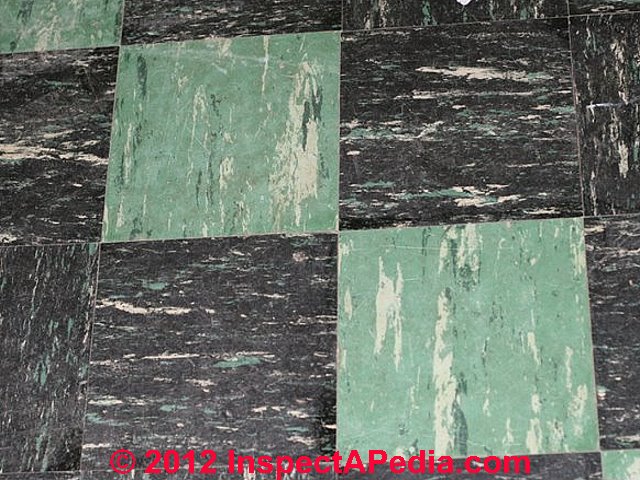
Unless tests are performed (usually not necessary) and results indicate otherwise, I would treat this flooring as PACM presumed asbestos containing material and handle it accordingly. We ask readers to let us know if you test the flooring and what you learn (a single asbestos test is not expensive, about $50. U.S.) - what we learn will help others.
1970's Floor Tile or Sheet Flooring Identification Requests
Please see the new home for this information: 1970's Floor Tile or Sheet Flooring Identification Requests
1980's Floor Tile or Sheet Flooring Identification Requests
Question: does this early 1980's Peel-and-Stick Floor Tile have an Asbestos Risk?
Please see ASBESTOS FLOOR TILE ID REQUESTS 1980's or LATER or Sheet Flooring Identification Requests
What to Do About Unidentified Flooring that May Contain Asbestos
If you are facing a costly demolition then it would make sense to confirm asbestos content using a certified asbestos test lab
See details at ASBESTOS TESTING LAB LIST
Else it makes sense to treat the material as "Presumed Asbestos Containing Material" or "PACM" flooring based on its age and appearance.
Reader Question: How can I Submit a Floor Tile Photo for Identification
How can I submit a photo of a tile to see if it might contain asbestos? - (Apr 3, 2014) Anonymous
Reply:
Sure, Anon, just use "Add Image" button at the bottom of this InspectApedia.com page - but it may not be necessary.
If you've got vinyl or asphalt floor tiles installed before the early 1980's it would make sense to treat them as presumed to contain asbestos (PACM or "Presumed Asbestos Containing Material") - and to avoid making a dusty demolition, sawing, grinding mess.
...
Reader Comments, Questions & Answers About The Article Above
Below you will find questions and answers previously posted on this page at its page bottom reader comment box.
Reader Q&A - also see RECOMMENDED ARTICLES & FAQs
Does this 12x12-inch tile look like asbestos flooring?
Wondering if this looks likely to be asbestos tile. It’s 12x12, glue under looks yellowish to brown. Had nothing under it, recently placed carpet on top. - On 2023-01-28 by Monty
Reply by InspectApedia Editor
@Monty,
Take a look at the live link in the Recommended Articles for
DOES THIS FLOOR CONTAIN ASBESTOS? - 5 easy questions to tell if your FLOOR probably contains asbestos -
More information would be needed to be able to give you a definite answer. Those questions should help.
Keep in mind that if it does contain asbestos, the safest and simplest thing to do is to cover it with new flooring. More on that can also be found in that same article list.
Asbestos in rhis Congoleum Nairn flooring?
Is this asbestos flooring? [Notice the word "NAIRN" imprinted on the flooring's underside - Ed.]
On 2023-01-13 by Louis Konowal
Reply by InspectApedia Publisher
@Louis Konowal,
It is certainly possible that that flooring contains abestos.
Please see
1970's CONGOLEUM FLOORING
How to figure out if this flooring contains asbestos
Any help with I.D. Of this flooring? Has a paper backing with fibers that look like fiberglass - On 2022-11-26 by Justin T
Reply by InspectApedia (Editor)
@Justin T,
That's a common pattern type and with no information about the country and city of location nor building age nor an estimate of flooring age so the best we can say is that you can make a reasonable guess at the asbestos question by clicking on the link in the recommended articles titled
Does this floor contain asbestos?
https://inspectapedia.com/hazmat/DIY-Asbestos-Material-Test.phpFollowup by Justin T
@InspectApedia (Editor),
Thank you this floor was installed over hardwood in 1987 it’s Armstrong from what my father told me and it is in an old home in Rhode IslandReply by InspectApedia (Editor) - 1987 Rhode Island Armstrong flooring installed over hardwood won't contain asbestos
@Justin T,
In the US vinyl floor installed in 1987 would not have contained asbestos unless it was old stock from 1986 or earlier.
Is this floor tile likely to contain asbestos?
Hi is this likely to contain asbestos
- On 2022-11-09 by Kevin
Reply by InspectApedia (mod) - more contextual information required to determine flooring content
@Kevin,
With no additional contextual information such as age or location, please see our article:
DOES THIS FLOOR CONTAIN ASBESTOS? - 5 easy questions to tell if your FLOOR probably contains asbestos
The live link to that page is in the list of Recommended Articles on this page.
Does this Wood Parquet pattern flooring contain asbestos?
My house was built in early 70s does it contain asbestos. - On 2022-06-07 by Sheila
Reply by InspectApedia (mod)
@Sheila,
Assuming that your "it" is asking about just the flooring, not the whole house, our answer is similar as that given to reader Michael N. just below.
Since the flooring was installed before 1986 and if the property is in the United States, it's possible that it contains asbestos. We would recommend that you treat that vinyl or asphalt based tile or sheet flooring flooring as presumed asbestos containing materials (PACM).
Asbestos containing flooring is safe and legal and can be left in place when it's in good condition and is not shedding material through grinding, sanding, chopping, etc. Best procedure is to leave it there and to cover it over with materials.
More details on coating or covering such floors are at ASBESTOS FLOORING HAZARD REDUCTION.
https://inspectapedia.com/hazmat/Asbestos-Flooring-Hazard-Reduction.php
Asbestos in 1970's cork style or pattern flooring?
We just had a flooring salesman in to replace some old carpeting and he said there is asbestos tile under the carpeting (how he would know from seeing a small corner is another matter).
House was built in 1972, so it is definitely possible, but now there is concern about the tile in the basement.
Could not find this particular design anywhere, nor could I find an old box of the tile. So, assistance would be greatly appreciated! Thanks! - On 2022-06-07 by Michael N.
Reply by InspectApedia-911 (mod) - 1972 cork pattern basement flooring may contain asbestos - if it's not real cork
@Michael N.,
Is this a tile floor or sheet flooring?
If it's tiles, those centers that look like a cork-pattern, certainly, if from the 1970s, are likely to be an asbestos-containing material.
That is absolutely no reason to panic nor to do something expensive.
Nor should its presence deter covering the floor with new material.
If the flooring was installed before 1986 and the property is in the United States, then it's possible that it contains asbestos. We would recommend that you treat that flooring as presumed asbestos containing materials (PACM).
Asbestos containing flooring is safe and legal and can be left in place when it's in good condition and is not shedding material through grinding, sanding, chopping, etc. Usual procedure when there's an asbestos floor covering in place is to leave it there and to cover it over with materials.
More details on coating or covering such floors are at ASBESTOS FLOORING HAZARD REDUCTION.
inspectapedia.com/hazmat/Asbestos-Flooring-Hazard-Reduction.php
1972 Florida condo wall board concern about asbestos
Decorative wall board from 1972 condo in Florida.
Is this asbestos? We are planning to remove this since it is unattractive. So cut a small piece and send out to test? - On 2022-05-24 by Patricia Steele
Reply by InspectApedia-911 (mod) -
@Patricia Steele,
I'm not certain but zooming in on the photo it appears to me that we're seeing a gray paper product- like material.
See DOES THIS MATERIAL CONTAIN ASBESTOS?
https://inspectapedia.com/hazmat/DIY-Asbestos-Material-Test.php
Probably not asbestos but if you need to demolish the material you should probably have a samples tested. If you decide to do that keep us posted.If you can leave in place and cover over with drywall, that would be less costly and cleaner and safer regardless of what the material actually is.
What's the risk of asbestos in these black floor tiles that are breaking up?
Hello does these look like these tiles
or the black stuff underneath contains asbestos
their breaking up need to know
before I fix please if anyone can help - On 2022-05-19 by Danielle
Reply by Friedmandaniel911 (mod) - black floor tile and mastic from before the mid 1980's is likley contain asbestos
@Danielle,
Quite likely if the floor is in the U.S. and older than the mid 1980s - which is how it appears.
To make a more-confident guess, see the live link and helpful questions in the Recommended Articles list
DOES THIS FLOOR CONTAIN ASBESTOS? - 5 easy questions to tell if your FLOOR probably contains asbestos -
Risk of asbestos in brick pattern floor tile from the 1950s
Thinking about buying this house but scared it may have asbestos , home was built in 1957 and I’m not sure if that flooring and ceiling tile was original but it is throughout the entire house
On 2022-04-11 by Frank
On 2022-04-11 by Inspectapedia Com Moderator (mod) - presence of asbestos is only ONE concern during home inspection and maybe not the most-urgent
@Frank,
If the flooring was installed before 1986 and the property is in the United States, then it's possible that it contains asbestos. That's absolutely not something to panic about.
Asbestos containing flooring is safe and legal and can be left in place when it's in good condition and is not shedding material. Usual procedure when there's an asbestos floor covering in place is to leave it there and to cover it over with materials.
Cost of doing that should be a trivial percentage of the value of just about any home that you might buy.
You also need to guard against the danger of having your attention so captured by one item that makes you nervous that you fail to pay attention to the entire property. You might miss other conditions that are far more important.
It would be very unusual for the presence of asbestos containing materials in a home to be the slightest reason not to buy the property.
In purchasing any building you need to have an accurate idea of what costs you will face to make it fit to your needs.
That cost will include repairs or modifications including possibly the removal or covering of asbestos-containing materials.
What you should expect from a professional home inspector, one who is working for you not for other parties and therefore has no conflict of interest, is a thorough inspection of the entire building and its mechanical systems, inspecting inside and outside, and providing you with a written report which documents the findings.
That report, to be most useful, will identify three categories of observations in which the house is in control of your money.
Those include things that are dangerous, things that don't work, and things that are causing rapid costly damage to the building. Those are things that are urgent. And some of those may be costly.
Completely separate from those three categories are other conditions or things that you want to find fix or improve. Those are elective in terms of when they're done. So for those categories you are in charge of your money and when it gets spent.
Worried about asbestos in 9x9 floor tile in a 1910 house
I pulled up some carpet in my 1910 house to find this 9x9 tile.
It has a layer of paint or something over it but the color is sort of grey-green with beige, black, and pink pattern. Going through your photo guide it looks a lot like the Armstrong or Kentile tile from the 40’s-50’s but I couldn’t find an exact color / pattern match for an ID.
I decided to get a piece tested, fully expecting it to come back positive, but to my surprise it came back negative. The lab looked at the tile itself and the black adhesive underneath and described the tile as vinyl “99-100% opq” and the adhesive as “70-80% cellulose and 20-30% tar”, both with no asbestos found.
I’m trying to decide what to do with this now because while I know a false negative is unlikely, I really expected it to be asbestos tile just because it looks exactly like it was made in that time period. Is it possible that it is really non asbestos tile? Should I treat it like it is asbestos just in case the lab was wrong? - On 2022-04-04 by Amie
Reply by Inspectapedia Com Moderator (mod)
@Amie,
From the floor tile age - probably late 1960s or early 1970s, I too would have expected it to contain asbestos - as most (but not all) did during that era. (Not ALL floor tile, even from that era, contains asbestos.)
In any event if a floor tile isn't being demolished, ground, sanded, chopped, etc. then there's not a high risk of release of high levels of airborne particles.
So the "treat it as if it contained asbestos" advice is still useful: if the floor is mostly intact and can be left in place, that's the best course of action (more details on coating or covering such floors areat ASBESTOS FLOORING HAZARD REDUCTION)
Only if you are forced to demolish the floor, creating a dusty mess, might I be concerned enough to look harder at the test lab report, as demolition of asbestos-suspect flooring involves a significantly higher cost (and potential hazards) than leaving it in place.
What are your plans for the room where you're lifting carpet? New floor covering of some sort? Most likely.Followup by Amie
@Inspectapedia Com Moderator, My intent was to install nail-in hardwood flooring.
I understand that I may be able to install hardwood directly into the tile, but in doing so, would be creating a small disturbance of the tile by shooting nails/staples into it (which of course only matters if there is really asbestos), or I could remove the tile and install hardwood over the subfloor.
So, in either scenario I'm concerned about the lab being wrong, but demolishing and removing the tile would obviously create a much bigger disturbance.
The lab I used is an accredited lab which used EPA Method 600/R-93/116 or 600/M4-82-020, by polarized light microscopy. If I do demolish the tile, should I consider having it analyzed a different way?Reply by Inspectapedia Com Moderator (mod) - test results may not ease worry over asbestos
@Anonymous, Amie
I look forward to seeing the asbestos test lab report - you'll send to us by using the page top or bottom CONTACT link.Generally I trust certified asbestos test labs - that's about all we can do.
At the end of the day everything depends on how the lab technician proceeded to prepare, mount, examine, and report the sample. In turn you're depending on both the technician and the lab supervisor.
And yes there are some vinyl floor tiles from the "had asbestos" era that don't contain asbestos, such as some of the Kentile products made near the end of that product's life, more likely from the 1980s.
What would we do if you got a second test that found asbestos (other than show me that report as I'd sure like to see that)? Would we have to then go to a third lab so we could vote for 2 out of 3?
If you can shoot flooring nails through the existing tiled floor successfully - without causing tiles to come up or break apart, that approach may be fine. You'd put down a layer of felt or underlayment anyway before starting the floor installation.
But test the fastening scheme first to see if it's going to work shooting through those tiles as if they start to come loose or break up you may end up not only with un-wanted demolition debris but with an un-even nailing surface.Reader follow-up: asbestos not found in old Floor tiles in Richmond CA
Attached is the ASBESTOS TEST REPORT for CALIFORNIA FLOOR TILES [PDF] lab report pertaining to the floor ID thread I was commenting on today (Amie, here).
I was particularly surprised because I submitted three samples from three different areas of the house which I thought might have asbestos:
AH-floor-01 is the tile referenced in the discussion above. They seem to have split it into two samples: the tile and the tar stuck to it)
AH-pipe-01 was from a cement-filled metal flue pipe in my kitchen
AH-off-01 was black mastic tar material from a different, equally old-looking tile floor in a different area my house
Result was none detected for all of the samples. Definitely a relief, but seems like it might be too good to be true. If you have any thoughts on the validity of this report I'd love to hear them.
Regardless, thank you for your input! Hard to know where to start with a problem like this and I really appreciated your website.
Moderator reply re: asbestos not found in old Floor tiles in Richmond CA
Often a floor tile is comprises of three layers: visible upper surface - the pattern, a central filler core, and a baker.
And historically asbestos was most-likely in the backer or in the core of the tile.
It also makes sense to test the mastic separately - it's a layer of its own.Certainly there are some vinyl floor tiles from the "asbestos era" that have been found not to contain asbestos, such as some of the later 12x12" Kentiles. 9x9's are more-likely to contain asbestos.
How to Best Manage the hazard of Asbestos in small area of 1960's floor tile: Instructions for people who don't like detailed procedures
This tile is in the bathroom of a house my parents built in 1966-67.
I now own the house and we are making some repairs before my son moves into it.
I suspect asbestos, but it is a small area of tile about 4' by 7'.
Hoping there is a way to just seal it off. - On 2022-03-24 by Susan
Reply by Inspectapedia Com Moderator - how to minimize the asbestos hazard from floor tiles
@Susan,
Certainly:
You will see complete details at ASBESTOS FLOORING HAZARD REDUCTIONFollowup by Susan
@Inspectapedia Com Moderator, I am still not certain after reading that hownto handle this floor. These are 12x12 tiles most of which are still on the floor.
They have been in their present shape for a while after a family member ripped out bathroom carpeting that was over them.
Until yesterday I thought it was only a small tile near the toilet that was loose (see image).
But I removed a portable set of plastic drawers and found more under it, which is the pic I posted yesterday. Avoiding the room now, keeping the door closed.
Should I discard the loose tile and just try to seal off the remaining tile and black adhesive, and if so with what sealer?
Reply by Inspectapedia Com Moderator - Review steps to reduce asbestos flooring hazards
@Susan,
Were you willing to look at our complete guide at ASBESTOS FLOORING HAZARD REDUCTION ? The basic steps we describe are simple in concept:
1. Pick up loose tiles
2. Damp wipe / HEPA vac any debris or dust
3. Seal the cleaned floor surfaces
4. Cover with new flooringFollowup by Susan - too hard to read detailed asbestos flooring hazard instructions on my phone
@Inspectapedia Com Moderator, Yes I tried to read thru all of that but on my phone it was nearly impossible to get thru all of it.
Even on my laptop, I am not sure I was able to string together all the items you listed, but let me respond further to what you listed:
Pick up loose tiles - would it be appropriate to put these in regular garbage pickup, or on site dumpster when it arrives?
Damp wipe / HEPA vac - this does not sound too hard to do provided I can find a hepa bag for any of the bag vacuums in the house.
Seal the surfaces - this is one of the items I am unsure of. I keep seeing ads for a product called Perfect Primer -- would something like that work along with hopefully putting a thin layer of plywood over it, prior to new flooring?
Cover with new flooring - this will likely be stick on vinyl tile or possibly a floating tile
Thank you for your help.On 2022-03-27 by Inspectapedia Com Moderator - How to fill in and level space left by removed tiles
@Susan,
It sounds as if you'd be best served by hiring an asbestos flooring abatement contractor, though for a small area of floor tiles that may be more costly than was really necessary. Basic steps besides what we mentioned above might be:
1. Place broken tiles in plastic bag and dispose of them.
2. Level the surface before installing new flooring
For products used for leveling and filling in the space left by the removed tiles, see
FLOOR LEVELING COMPOUNDS & FILLERS
where we list a number of products that will work depending on what the new flooring will be.We appreciate the feedback. We will review the article to see if we can make it more manageable or to provide an alternative summary version.
Please Identyify thes Floor Tiles and tell me if they contain asbestos
This was in older public place.
Can you ID these tiles.
On 2022-03-12 by Len
On 2022-03-12 by Inspectapedia Com Moderator - Photos alone can't always determine asbestos content
@Len,
That flooring might contain asbestos if it was installed in a building in North America before 1987. From a photo one can’t answer your question with certainty.
Popular flooring patterns were continued, without asbestos, after 1986. Have a sample of the flooring tested, or you can make a reasonable *guess* at whether or not the floor contains asbestos by answering the few easy questions found at:
DOES THIS FLOOR CONTAIN ASBESTOS? - 5 easy questions to tell if your FLOOR probably contains asbestos -
...
Continue reading at DOES THIS FLOOR CONTAIN ASBESTOS? or select a topic from the closely-related articles below, or see the complete ARTICLE INDEX.
Or see ASBESTOS FLOOR TILE IDENTIFICATION FAQs - questions & answers posted originally at the end of this page
Or see these
Recommended Articles
- ASBESTOS DISPOSAL REGULATIONS
- ASBESTOS FLOOR TILE COMPOSITION
- ASBESTOS FLOORING DAMAGE HAZARDS
- ASBESTOS FLOORING HAZARD LEVEL ASSESSMENT
- ASBESTOS FLOORING HAZARD REDUCTION
- ASBESTOS FLOOR TILE IDENTIFICATION COLOR KEY - home
- ASBESTOS FLOORING IDENTIFICATION GUIDE INDEX - all brands, all years
- ASBESTOS FLOORING REMOVAL GUIDE
- ASBESTOS REMOVAL, WETTING GUIDELINES
- ASBESTOS RISK ASSESSMENT
- ASBESTOS TEST RESULTS for TILE & SHEET FLOORING
- ASBESTOS TESTING LAB LIST
- DOES THIS FLOOR CONTAIN ASBESTOS? - 5 easy questions to tell if your FLOOR probably contains asbestos -
- DOES THIS MATERIAL CONTAIN ASBESTOS? - 5 easy questions to tell if a BUILDING MATERIAL probably contains asbestos -
- HAZARD vs RISK - what's the difference, why you should care
Suggested citation for this web page
ASBESTOS FLOOR TILE PHOTO ID REQUESTS at InspectApedia.com - online encyclopedia of building & environmental inspection, testing, diagnosis, repair, & problem prevention advice.
Or see this
INDEX to RELATED ARTICLES: ARTICLE INDEX to ASBESTOS HAZARDS
Or use the SEARCH BOX found below to Ask a Question or Search InspectApedia
Ask a Question or Search InspectApedia
Try the search box just below, or if you prefer, post a question or comment in the Comments box below and we will respond promptly.
Search the InspectApedia website
Note: appearance of your Comment below may be delayed: if your comment contains an image, photograph, web link, or text that looks to the software as if it might be a web link, your posting will appear after it has been approved by a moderator. Apologies for the delay.
Only one image can be added per comment but you can post as many comments, and therefore images, as you like.
You will not receive a notification when a response to your question has been posted.
Please bookmark this page to make it easy for you to check back for our response.
IF above you see "Comment Form is loading comments..." then COMMENT BOX - countable.ca / bawkbox.com IS NOT WORKING.
In any case you are welcome to send an email directly to us at InspectApedia.com at editor@inspectApedia.com
We'll reply to you directly. Please help us help you by noting, in your email, the URL of the InspectApedia page where you wanted to comment.
Citations & References
In addition to any citations in the article above, a full list is available on request.
- Thanks to reader R.M. for the photo and test information documenting chrysotile asbestos in a vinyl-asbestos floor tile from a 1969 home. January 2011.
- Thanks to reader Kim for the photo of black and white VAT resembling Armstrong Excelon from a 1952 home - January 2011.
- EVER WEAR TILE CO is currently (2009) in the Terrazzo, Tile, Marble, and Mosaic Work industry in Fallon, NV. 775) 423-6221. [We do not know the company history nor whether there is an association with EverWear vinyl asbestos floor tiles discussed in this article.]
- "Asbestos in your home or at work," Forsyth County Environmental Affairs Department, Winston-Salem NC 12/08
- "Asbestos Floor Tile Removal", the University of Minnesota's advice on removing VAT (vinyl asbestos or asphalt asbestos floor tile) can be read in detail at www.health.state.mn.us/divs/eh/asbestos/floortile/index.html
- EPA, ASBESTOS IN YOUR HOME [PDF] - U.S. EPA, Exposure Evaluation Division, Office of Toxic Substances, Office of Pesticides and Toxic Substances, U.S. Environmental Protection Agency, Washington,D.C. 20460
- Resilient Floor Covering Institute, 1030 15th St. NW, suite 350, Washington D.C.
- Asbestos products and their history and use in various building materials such as asphalt and vinyl flooring includes discussion which draws on ASBESTOS, ITS INDUSTRIAL APPLICATIONS, ROSATO 1959, D.V. Rosato, engineering consultant, Newton, MA, Reinhold Publishing, 1959 Library of Congress Catalog Card No.: 59-12535 (out of print).
- EPA Guidance for Controlling Asbestos-Containing Materials in buildings, NIAST, National Institute on Abatement Sciences & Technology, [republishing EPA public documents] 1985 ed., Exposure Evaluation Division, Office of Toxic Substances, Office of Pesticides and Toxic Substances, U.S. Environmental Protection Agency, Washington,D.C. 20460
- In addition to citations & references found in this article, see the research citations given at the end of the related articles found at our suggested
CONTINUE READING or RECOMMENDED ARTICLES.
- Carson, Dunlop & Associates Ltd., 120 Carlton Street Suite 407, Toronto ON M5A 4K2. Tel: (416) 964-9415 1-800-268-7070 Email: info@carsondunlop.com. Alan Carson is a past president of ASHI, the American Society of Home Inspectors.
Thanks to Alan Carson and Bob Dunlop, for permission for InspectAPedia to use text excerpts from The HOME REFERENCE BOOK - the Encyclopedia of Homes and to use illustrations from The ILLUSTRATED HOME .
Carson Dunlop Associates provides extensive home inspection education and report writing material. In gratitude we provide links to tsome Carson Dunlop Associates products and services.


